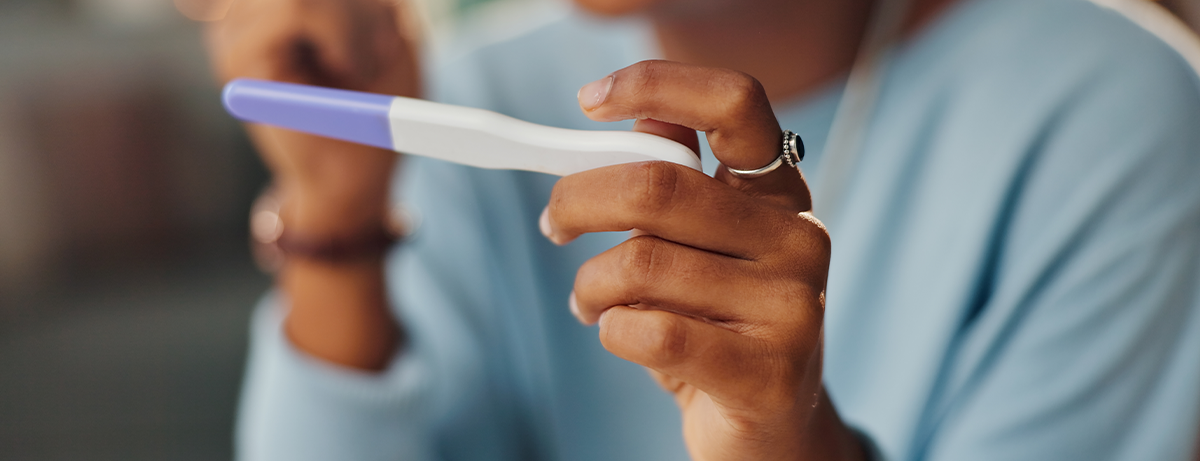15% off £25 or 20% off £35
Code:BASKET
Fertility and ovulation: what you need to know

Can you tell when you’re ovulating? It’s tricky, we get it – but unlocking this (not-so-secret) key could be a game-changer if you’re trying for a baby
Summary
1What’s ovulation?
Ovulation is the process where a mature egg is released from one of the ovaries and travels down the fallopian tube, ready for fertilisation…
2How long does ovulation last?
Once released from the ovary, the egg lives for about 24 hours. However, the fertile window…
3How to calculate your ovulation and fertile days
Knowing your ovulation day can be helpful if you’re trying to conceive (or avoid pregnancy)…
Understanding your body’s monthly cycle can be empowering, especially when it comes to planning (or preventing) pregnancy. Ovulation is at the heart of fertility, and knowing when it happens can help you determine your most fertile days.1
So how do you know, exactly? Let’s explore what ovulation is, the perfect timing for conception and the signals your body sends every month.
What’s ovulation and when does it happen?
Ovulation is the process where a mature egg is released from one of the ovaries and travels down the fallopian tube, ready for fertilisation.2
But how and when does this all happen? You may have heard of the different phases of your cycle, and ovulation takes centre stage right in the middle:3
- after your period (menstruation), your body enters the follicular phase, during which a mature egg begins to develop in the ovaries
- a surge in luteinising hormone (LH) then triggers ovulation, and the egg is released
- the body then enters the luteal phase, during which it prepares for pregnancy. The lining of the uterus (womb) becomes thicker in anticipation of a fertilised egg
- if fertilisation doesn’t happen, the lining breaks down and you’ll have your period
How long does ovulation last?
Once released from the ovary, the egg lives for about 24 hours.1
However, the fertile window, the time when you can get pregnant, lasts longer than just one day.

Fertility and the ovulation cycle: your questions answered
Your fertile window typically starts about five days before ovulation and lasts until 12 to 24 hours after ovulation.4
This is because sperm can survive in the body for up to five days. So, sperm that entered the reproductive system days earlier can still be present and fertilise the egg once it’s released.1
The best time to try is 1–2 days before ovulation, particularly on days when you notice clear, stretchy, slippery cervical fluid (discharge), which helps optimise sperm survival and transport.4
Sperm can survive longer than an egg, so if they’re already present when the egg is released, you have the best chance of conceiving.1
Even with the best timing in the world, getting pregnant is certainly not guaranteed. The highest probability of pregnancy per cycle is typically around 20 to 40%, and it can vary based on factors like age and individual differences.4
If you’re experiencing fertility issues, the chances may be lower,4,5 but remember, many people conceive after a few cycles, and there are plenty of support options available if you need them.4,5
After ovulation, the egg will only survive for about 24 hours.1 This is a very short window, which is why it’s better to try before ovulation – the chance of fertilisation is highest when sperm are already present in the fallopian tubes.1
How to calculate your ovulation and fertile days
Knowing your ovulation day can be helpful if you’re trying to conceive (or avoid pregnancy), especially if you have an irregular cycle or are experiencing fertility issues.4
Below are some methods to help estimate your ovulation and fertile days.
If you have a regular cycle, tracking it on a calendar (or using a period tracker) can give you a good estimate of your fertile days. Ovulation typically occurs about 14 days before the start of your next period in a 28-day cycle. However, this method isn’t always reliable, as patterns can vary even in people with regular cycles.6
Your basal body temperature is the temperature of your body at rest.7 From just after ovulation until the start of your next period, most women’s body temperature increases very slightly – by about 0.5°C.7
Your most fertile days are the two or three days before this temperature rise, so BBT isn’t the most effective tool for planning a pregnancy.1 However, it can help confirm that ovulation has already occurred.1
If you do track your temperature, be sure to do so at the same time every morning, right after you wake up.7
Cervical mucus (discharge that comes from your cervix) changes throughout your cycle. Just before ovulation, the amount increases, and it becomes thin and slippery, resembling raw egg whites.1,8
This mucus helps with sperm survival and transport, so when you notice it, it can be a good time to try for a baby.1,4
OPKs measure the levels of LH in your urine, the hormone that surges right before ovulation and triggers the release of a mature egg.3,9 Some studies suggest that using OPKs may help improve the chances of pregnancy for those trying to conceive, but more research is needed to confirm this.9,10
Explore more about fertility tests and how they can support your journey in our dedicated article on fertility tests.
There are many cycle tracking apps that can analyse your monthly cycles and predict your fertile window.6,11
Most are based on the calendar method, but some also incorporate other approaches. By entering data from OPKs, BBT tracking and cervical mucus monitoring, you can get a more accurate prediction. With so many apps available, be sure to choose one that uses evidence-based methods.6
It’s important to consider the accuracy of fertility apps if you’re planning to use them.6,11 Many fertility tracking apps allow you to note your basal body temperature.6 However, this can be influenced by several factors, like drinking alcohol or being stressed, which means what your app shows you might not be completely accurate.6,7
You should also think about how your data is processed and stored to be confident it’s properly protected.11
Common fertility challenges
If you’ve been having trouble conceiving, know that you’re not alone. Around one in seven couples may experience challenges when trying to get pregnant.5
Both men and women can face fertility issues. In women, this often comes in the form of problems with ovulation. In some cases, an egg isn’t released at all (a condition known as anovulation), or the release may be irregular.12,13
Common causes include polycystic ovary syndrome (PCOS), thyroid problems and hypothalamic amenorrhea (when your hypothalamus causes your period to stop), which can lead to irregular periods or no periods at all.12-14 These conditions can make it more challenging to conceive.
Being overweight or underweight may affect your fertility.5 This is because not being a healthy weight can impact ovulation, making it more difficult for you to conceive.5 Excessive exercise may also cause menstrual irregularities or missed periods which can lead to problems when ovulating.4
If you’ve been trying to conceive for over a year, or if you’re aware of potential fertility concerns, it’s recommended to speak to your GP. They can provide support and discuss possible treatments.4
The final say
Pregnancy and the journey to it are unique for everyone. While it’s not a fail-safe method, understanding ovulation and your cycle can help you connect more deeply with your body and appreciate the amazing things it’s capable of.
To learn more about fertility, planning for a baby and pregnancy, check out our dedicated fertility and pregnancy hub.
The advice in this article is for information only and should not replace medical care. Please check with your GP or healthcare professional before trying any supplements, treatments or remedies. Food supplements must not be used as a substitute for a varied and balanced diet and a healthy lifestyle.
While we strive for accuracy and balance, please be aware that this article may discuss products available for purchase through Holland & Barrett. Consult a healthcare professional before making any health-related decisions.
1. ACOG. Fertility awareness-based methods of family planning [Internet]. [cited 2024 Dec 6]. Available from: https://www.acog.org/womens-health/faqs/fertility-awareness-based-methods-of-family-planning
2. ACOG. The Menstrual Cycle: Menstruation, Ovulation, and How Pregnancy Occurs [Internet]. [cited 2024 Dec 6]. Available from: https://www.acog.org/womens-health/infographics/the-menstrual-cycle
3. Thiyagarajan DK, et al. Physiology, Menstrual Cycle. StatPearls [Internet]. [cited 2024 Dec 6]. Available from: https://www.ncbi.nlm.nih.gov/books/NBK500020/
4. Duane M, et al. Fertility awareness-based methods for women’s health and family planning. Front Med (Lausanne). 2022;9:858977. https://doi.org/10.3389/fmed.2022.858977
5. NHS. Infertility: overview [Internet]. [cited 2024 Nov 7]. Available from: https://www.nhs.uk/conditions/infertility/
6. Ali R, et al. Do fertility tracking applications offer women useful information about their fertile window? Reprod Biomed Online. 2020:S1472-6483(20)30509-5. https://doi.org/10.1016/j.rbmo.2020.09.005
7. Steward K, Raja A. Physiology, ovulation and basal body temperature. Treasure Island (FL): StatPearls Publishing; 2024. Available from: https://www.ncbi.nlm.nih.gov/books/NBK546686/
8. PregnancyInfo.ca. Cervical mucus testing [Internet]. [cited 2024 Dec 6]. Available from: https://www.pregnancyinfo.ca/before-you-conceive/fertility/tools-for-understanding-fertility/cervical-mucus-testing/
9. Gibbons T, et al. Timed intercourse for couples trying to conceive. Cochrane Database Syst Rev. 2023;9(9):CD011345. https://doi.org/10.1002/14651858.CD011345.pub3
10. Johnson S, et al. Increased Likelihood of Pregnancy Using an App-Connected Ovulation Test System: A Randomized Controlled Trial. J Womens Health (Larchmt). 2020 Jan 13;29(1):84–90. https://doi.org/10.1089/jwh.2019.7850
11. Hohmann-Marriott B, Starling L. What if it's wrong? Ovulation and fertility understanding of menstrual app users. 2022 Dec;2:100057. https://doi.org/10.1016/j.ssmqr.2022.100057
12. NHS. Infertility: causes [Internet]. [cited 2024 Nov 7]. Available from: https://www.nhs.uk/conditions/infertility/causes/
13.Carson SA, Kallen AN. Diagnosis and Management of Infertility: A Review. JAMA. 2021;326(1):65–76. https://doi.org/10.1001/jama.2021.4788
14. World Health Organization. Polycystic ovary syndrome [Internet]. [cited 2024 Nov 7]. Available from: https://www.who.int/news-room/fact-sheets/detail/polycystic-ovary-syndrome












